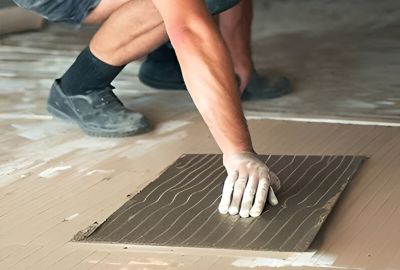When it comes to redesigning any high-use space of your home, underfloor heating is a great way to ensure they stay cosy and welcoming. However, like many home improvement DIY projects, there are a few things you need to be aware of if you plan on laying natural stone tiles or porcelain tiles on underfloor heating.
So, to make sure you get your subfloor and tiling adhesive right, we’ve outlined the common underfloor heating tiling problems – and more importantly, how to avoid them!
What to be aware of when tiling over underfloor heating?
Any floor that houses underfloor heating will eventually present problems in the form of constant and rapid temperature changes.
As with many construction materials, your tiles will naturally expand and contract over time when exposed to different temperatures. What this means is that your tiles will move and shift on the floor, which can result in them cracking or debonding from their adhesive, as a result of grinding against each other.
Fortunately, with the right choice of floor backing, adhesive, and grout, you can minimise the effects, and keep your floor tiles looking flat and fresh all year round.
How to prepare your tile subfloor for underfloor heating
Regardless of what surface you plan to tile over, if it has underfloor heating included, then you’ll need to make sure that you properly prepare the appropriate sub-floor to ensure that you minimise the effects caused by changing temperatures. Here is how to prepare the following types of sub-floor when tiling over underfloor heating:
- Calcium sulphate screeds – light in colour and fairly smooth, this type of screed is commonly picked due to its low cost and easy-to-lay properties, as well as offering self-levelling and minimal shrinkage. However, to get the most out of these benefits, you need to be sure you pick a flexible screed that responds well to temperature.
- Cement screeds – the most traditional sub-floor material used for tiling, cement screeds are made from a combination of sand and cement for a solid and durable surface. However, they’re less flexible than calcium sulphate screeds, meaning you’ll need to select a suitably flexible tile adhesive so that your tiles can handle the heat.
- Plywood – typically used if you want to tile onto wood, this plywood needs to be both thick enough to support the weight of your tiles and any potential foot traffic, as well as be screwed down in regular intervals to mitigate the effects of wooden floor bounce. You’ll also want to coat it in an SBR bonding agent to ensure it's sealed properly.
What adhesive should I use with underfloor heating?
With your subfloor prepared, the next step for anyone looking to tile over underfloor heating is to choose the right adhesive for their needs. This is a simple enough task that requires you to find an adhesive that works with your substrate, as well choosing one that is flexible under temperature changes.
Once you have your chosen adhesive, simply follow the typical tiling process for your specific subfloor and then proceed to grout your tiles. When fixing floor tiles over electric under-floor heating, both flexible adhesive and grout should be used as they will absorb the minute changes in movement which occurs as the underfloor heating heats and cools.
As an aside, when specifically tiling over electric underfloor heating, the spreading of your adhesive should be done with a plastic rather than a metal trowel, to avoid nicking any cables. Your adhesive should also be spread evenly to avoid air pockets, which could cause temperature hot spots that impact your tile might lie.
Other things to bear in mind when tiling over heated floors
Although the above tips will help you prevent the main difficulties that typically come with placing tiles over underfloor heating, there are several things you can do both before and after your project to ensure the best results.
1. Consider laying down a tile backboard regardless of the subfloor you’re using. These backboards are made of high-density, extrude polystyrene that is excellent at providing insulation, increasing the efficiency of your underfloor heating. They’re also very easy to install, only requiring you to screw it down on wood or adhere it to a concrete screed.
2. Make sure that your underfloor heating has been commissioned and tested by a qualified electrician so that it does not heat up past its upper-temperature limit or cause other issues which could lead to tiles lifting. Be sure to test it after installation as well to check no damage has been done to the heating system.
3. Once your tiles have been laid, you should avoid turning your heating on for at least 21 days, so the screed has time to cure properly.
And that’s it; you should now know everything you need to start tiling over a heated floor, though if you have any further questions, then be sure to reach out to the Stone Superstore team.
Don’t forget you find further tile installation advice guides in our help and advice hub, as well as home design inspiration over on our blog.


